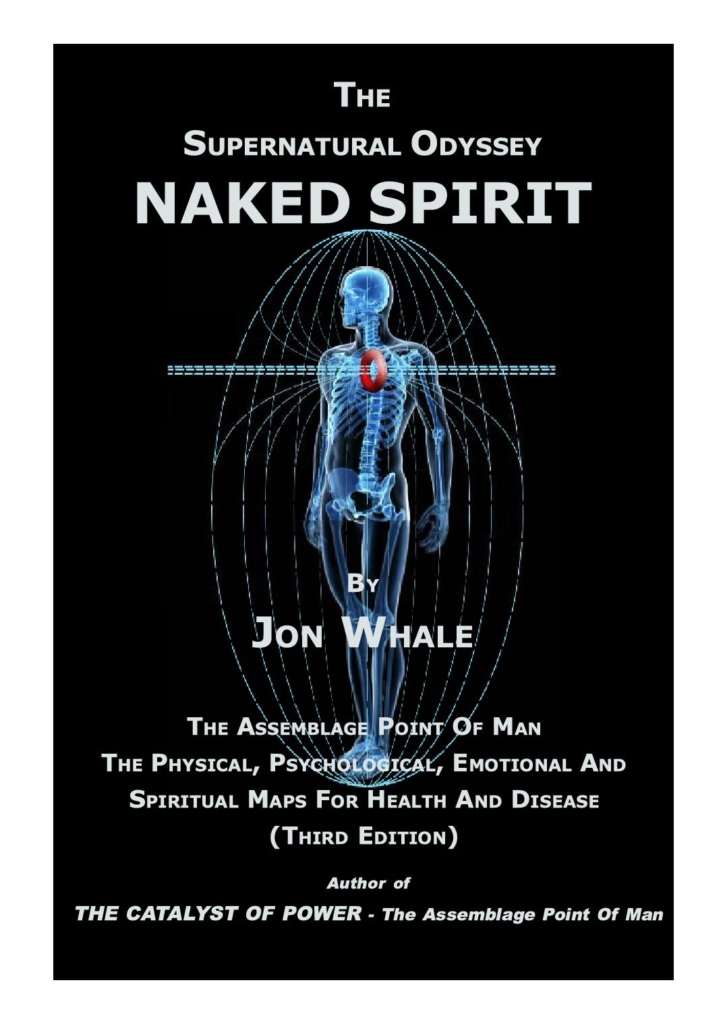This page is a short Introduction about the Assemblage Point
(Extracts from books by Jon Whale: The Catalyst of Power & Naked Spirit)

THE SEVEN RULES OF THE HUMAN ASSEMBLAGE POINT
1. At the physical, emotional, atomic and quantum levels, a human being is an independent oscillating energy field. All oscillating energy fields, by virtue of the fact that they are oscillating, must have an epicentre or vortex of the rotation. The epicentre of the human energy field is called the Assemblage Point.
2. The location and entry angle of the Assemblage Point with respect to the physical body dictates the shape and distribution of the human energy field.
3. The shape and distribution of the human energy field are directly proportional to the biological energy and activity of the organs and glands in the physical body, also to the quality of the emotional energy.
4. The biological activity of the organs and glands determines the position of the Assemblage Point, and thus the shape and distribution of biological energy throughout the physical body.
5. The location and entry angle of the Assemblage Point has a direct influence over the biological activity of all of the organs and glands including the brain and these have a direct influence on the location of the Assemblage Point.
6. The location and entry angle of the Assemblage Point regulates how we feel and behave. Disease also dictates the Assemblage Point location and entry angle.
7. The way we feel and the manner in which we behave; our state of health or disease and our ability to recover is reflected in the location and entry angle of our Assemblage Point.
The idea that how we behave and how we feel might be beyond our rational control is largely unbelievable to most healthy people. Such people are extremely fortunate as they have a stable, near central Assemblage Point.
This idea is acceptable and can be easily comprehended by anyone us who has experienced any of the following:.
1) Serious accident, bereavement, disease, fever, tragedy, chronic stress or depression.
2) Distressed or oppressed childhood, rape or sexual assault, violent intimidation, kidnapping, abduction, enslavement.
3) Self laceration, mutilation or poisoning, attempted suicide, substance and drug, indulgence, drug overdose, mental institution.
4) Mugging, robbery, burglary, fraud, identity theft.
5) Genocide, war, terrorism, homicide, torture, post military combat trauma, imprisonment.
6) Physical or psychological intimidation, interrogation, brainwashing.
7) Betrayal, financial or legal intimidation, blackmail, malicious divorce, bankruptcy, redundancy, home repossession, arrest, prosecution. Under any of these circumstances many people can undergo a serious or seemingly permanent change of their mood or even a personality change. They may also develop physical symptoms and illness. This may eventually lead to more serious disease.
Any of these incident types can and do cause an involuntary shift of the Assemblage Point to a dangerous location.
Our Assemblage Point location fixes in a healthy, stationary, near-central position at around the age of seven if we are brought up in a stable home environment and positively identify with good mother and father-figures.
But an unstable and displaced Assemblage Point is likely if we had a consistently negative relationship with our parents, a troubled background or having a displaced upbringing. Genetic reasons or disease can similarly produce abnormal and unstable Assemblage Points.
Sufferers of an involuntary Assemblage Point shift downwards experience that ‘something’ deep inside them has changed. Although they can remember how they behaved and felt before the incident, returning to their former energetic and happy self is impossible for them. That indescribable ‘something’ deep inside all of us that can suddenly shift following an adversity, changing our whole perception of reality and our physical health, is the location and entry angle of our Assemblage Point.
If the Assemblage Point drops beyond a certain distance for example, with chronic fatigue, down to or below the liver area, despite what medications or therapies are employed, it is very difficult for the individual to recover their former health and state of being. This is because, without direct intervention, their Assemblage Point is most unlikely to return to its previous healthy location. Literally the biological energy levels are too low, so preventing recovery. Raising the Assemblage Point location and angle upwards, closer to the centre of the chest, is an essential consideration in such cases. Unfortunately, accepted orthodox medical diagnostic and management procedures do not take the patient’s Assemblage Point location into consideration.
Gross misalignment of the Assemblage Point location is present in many diseases such as: Depression, post natal depression, bipolar syndrome, paranoia, schizophrenia, drug and alcohol addiction, epilepsy, senile dementia, coma, Parkinsonism, toxicity, leukaemia, cancer, auto immune deficiency syndrome, myalgic encephalomyelitis, multiple sclerosis, and many others. Many of these conditions are accompanied by compromised pathology of the patient’s haematology and biochemistry.
Extreme locations to the right side of the chest with an acute angle are associated with extrovert psychotic behaviour such as violence, bullying, rape, stalking, murder, terrorism or fanaticism.
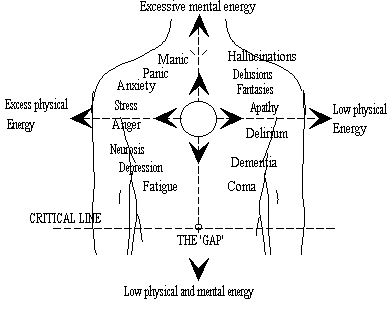
The ‘off centre’ map showing approximate locations for various symptoms.
First Published by Jon Whale In 1996
Extreme locations to the left side of the chest are associated with introvert psychotic behaviour such as hallucinations, autism and downs syndrome.
High locations are accompanied by symptoms of hyperactivity, anxiety, panic, insomnia and so on, along with hyper liver/adrenal activity. Attention deficit hyper activity disorder (ADHD) in children is now very common and is an example of this.
Low locations are accompanied with hypoactivity, the depressive illness spectrum and hypo liver/adrenal/thyroid activity.
The bipolar disorder spectrum or manic depression is accompanied by an oscillating Assemblage Point location which switches between a high manic location to a low depressive position on the right side of the chest.
With the autistic spectrum the Assemblage Point will almost certainly be found on the left.
With the schizophrenic spectrum there may be several Assemblage Point locations, as often happens with the epilepsy spectrum.
The Assemblage Point has a critical relationship with our embryonic life force. A good stable physical location near the centre of the chest is essential for good mental and physical health.
The location for an average healthy woman is slightly higher than that of an average healthy man.
If, for whatever reason, the Assemblage Point shifts outside the average location, distressing physical and mental symptoms can and do frequently occur. For example, following a traumatic incident, should the Assemblage Point drop down into the liver area, then the liver will become disturbed and will not function correctly. We will feel tired, lacking energy and the body will not respond to our mental commands. This can cause clinical depression, postnatal depression and chronic fatigue syndrome. Further, the liver’s blood supply is by way of the spleen via the portal circulation, and should the spleen’s blood pathways become constricted or congested, perhaps because of a previous chronic infection, then the liver will not function as it should and the Assemblage Point will drop downwards.
Concerning high blood pressure: the liver demands blood and if the spleen is congested or diseased then to satisfy its needs, the liver may change the blood’s chemistry in order to raise the heart rate and force more blood through the spleen.
On the other hand, should the Assemblage Point shift to the right and upper part of the chest the person will be feeling anxious and nervous and experience disturbed sleep. Here the liver and adrenals will be overactive. Manic depression is a bipolar condition where the Assemblage Point oscillates between a high location in the manic phase and a low liver location in the depressive phase.
The Assemblage Point is the unknown factor that is absent in all current medical, psychological, scientific, philosophical and spiritual models.
The public’s criticism of current medicines, therapies and treatment procedures can be addressed by the application of Assemblage Point diagnosis and correction procedures, especially if combined with good medical and psychological diagnostic and management procedures.
Hunger, thirst, shock, trauma, drugs, alcohol, accidents, violence, intimidation can and do cause the Assemblage Point to drop to a dangerously low location. If the Assemblage Point location is not corrected soon after the incident that was responsible for it to drop, then the victim’s haematology and biochemistry can change to levels outside the normal range of that of a healthy person. This may create the conditions for serious physical and mental disease to take hold such as cancer and leukaemia. When these serious diseases occur, the Assemblage Point location becomes even further depressed towards the critical line at the umbilical region. Ironically the drugs and therapies used in treatments for these diseases often depress the patient’s Assemblage Point location even further down towards the critical line. Death results when the Assemblage Point crosses the umbilical region. In the case of comatose patients on life support systems, regardless of any electroencephalogram tests, the patient will not be brain-dead until their Assemblage Point has traversed the umbilical region. It is advisable to take into consideration the location of the victim’s Assemblage Point as soon as possible after the incident that caused it to drop.
With all serious diseases in their chronic phase, the patient’s Assemblage Point will be found in a low location perhaps as much as 20 centimetres or more below that of a healthy person. Likewise, for those patients that have a serious physical or mental disease it is imperative for their recovery to adjust the location of their Assemblage Point back up to a location of that of a normal healthy person. This simple action will greatly help the patient’s restoration of normal haematology and biochemistry levels that are essential for good health. Not only are the Assemblage Point diagnostics and correction principals applicable to mental and physical disease but, for a normal healthy person, regular correction to the central location can dramatically improve mental and physical efficiency. This helps to produce stable and efficient functioning of the liver, spleen and other organs and glands and produces a stable state of well being that is most beneficial.
For optimum health and vitality, energies in the left and right sides of the brain should be equal and the Electromagnetic Field equally distributed about the body’s central meridian line. The ideal location for the Assemblage Point is the central position, shown in figure 1.1. In this position balanced biological energy flows around the central nervous system and the many organs and glands function in harmony. This ideal alignment is rare. With most people the Assemblage Point will be found entering on the right side of the chest’s central meridian line; this is due to the excessive left brain activity resulting in physical and mental activity, which is demanded by today’s stressful life style. Drugs, toxins, illness, accidents and emotional trauma are the most common causes of misalignment. Once misalignment has occurred, if not impossible, it is very difficult, to re-establish the original position by one’s own efforts or by orthodox medical therapies.
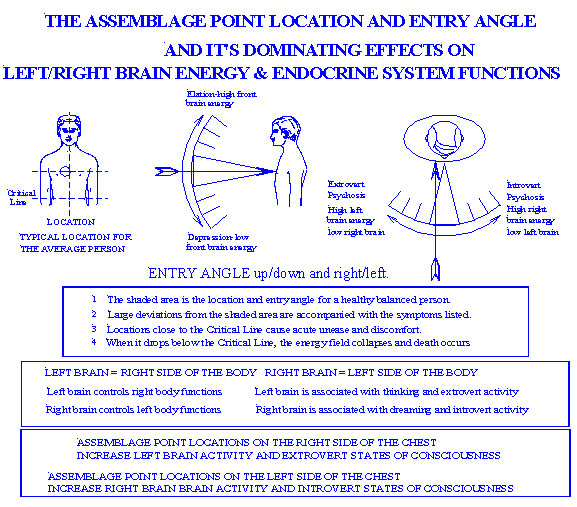
Figure 1.2. The effects of the Assemblage Point location and entry angles on brain energy.
The Stress of The Shift to The Right

Assemblage Point shift to the left.
This is the most commonly found misalignment, the symptoms of which are compulsive mental and physical activity illustrated by the following case studies. The medical diagnosis for those having their Assemblage Point in the above patient’s location is stress; excessive feelings of anxiety, panic or anger being indicators of this location. These are associated with high Beta brain-wave frequencies in the left brain. The Assemblage Point moves to the right side of the chest as shown in figure 1.8.
With paranoia the location and angle are to the right and down. In mania the location is high right and the angle is upwards. Manic depression and schizophrenia are associated with oscillations and splits in the Assemblage Point location. On the extreme right there are endless visions of physical activity, violence, killing and sensuality.
Intimidation, worry, overwork, insomnia, cocaine, L.S.D., amphetamines, antidepressants and excessive caffeine can drive the stationary Assemblage Point to the far right. In this position various physical symptoms medically connected with stress will appear. Energy demands are high and sleep will be problematic as High Beta frequency brain activity is present. The attention is external and the awareness of the physical body is attenuated. Locations further to the right cause psychotic behaviour which can include violence and sexual deviations. Left brain energy will be high, right brain low. From this position, drugs, illness or emotional trauma can cause complete exhaustion of the nervous system. The Assemblage Point then drops down towards the critical line at the solar plexus. M.E. is a disease with this location, the Assemblage Point always entering the patient from a low angle up through the liver. Shifting the Assemblage Point to the centre will give immediate relief, regular shifting will recondition the nervous systems back to normal, thus reducing or removing the patient’s dependence on drugs.
The Dangers of The Shift Below
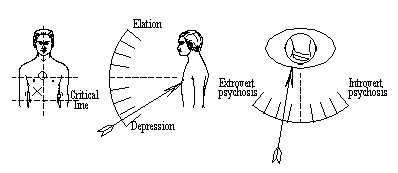
Assemblage Point shift below (right side).
This is a dangerous, uncomfortable and distressing location indicated by very low mental and physical energy with acute psychological instability and physiological disturbances. Frontal brain energy will be low impairing the functions of the endocrine glands and organs. From this location it is virtually impossible to recover without realignment of the Assemblage Point. As the Assemblage Point’s rear location or pivot point drops down from the shoulder blade area, muscular coordination becomes affected.
With this location, serious psychiatric or physical illness will often be present such as auto immune disease syndrome (A.I.D.S.), cancer, meningitis, cerebral thrombosis, apoplexy, clinical depression, post natal depression, myalgic encephalomyelitis (M.E. syndrome) and multiple sclerosis (M.S. syndrome). As the Assemblage Point moves towards the critical line, the symptoms worsen with Beta activity being mostly absent and distressing feelings and emotions prevalent. Sympathy, placation or chastisement do not help. Toxic material, heavy metals, chemotherapy drugs, poisoning, head injury, drugs, attempted suicide, solvent abuse, violent intimidation, physical shock, electric shock, long term exposure to strong electromagnetic and high voltage electrostatic fields, anoxia, infections and disease can drive the Assemblage Point to this location which cannot be corrected by anti depressants. Shifting the location up and over to the centre will immediately alleviate the symptoms. Vibrational levels will increase and more energy will be available even if physiological disease is present.
The Shift to the Left
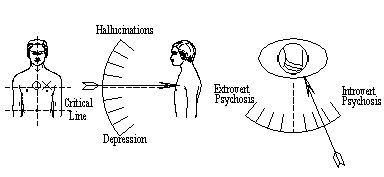
Assemblage Point shift to the left.
L.S.D. and other hallucinogenic drugs can cause a shift to the left (or in any direction). Pseudo religious cult brainwashing methods unconsciously shift the location to the left side (see ‘Off Centre Map’ above). Irrational preoccupation with daydreaming, fantasy, hallucinations and melancholia are the most common indicators for this location.
Locations on the extreme left side are associated with visions and experiences of spirituality, religion and God. If the location of the shift is minimal, the results are explained as fantasies of the mind. If the shift is considerable, the results are called hallucinations. Shifting the Assemblage Point to right of the centre will return behaviour to normal increasing left brain energy, Beta frequencies and rationality.
Senile dementia, autism, Down’s Syndrome and coma are examples where the location will be around the area shown (see ‘Off Centre Map’ above). In the early stages of these diseases regular checks and correction of the Assemblage Point may slow the progress. Doctors and clinicians will in future reverse these diseases by combining Assemblage Point realignment with other therapies. For energy medicine treatment of senile dementia and autism.
How to Locate and Experience the Assemblage Point
Locating and experiencing our Assemblage Point gives us personal proof that in addition to our physical body, we all have an energy body. Working with the energy body is not a trivial affair. The Assemblage Point, in particular is particularly personal, directly connected to the ‘life force’ of the individual.
The Assemblage Point is a cluster of strong energy lines or strings. Close to the body they have an average diameter of about 1.0 centimetre or less. These lines pass through the chest and out of the back not unlike the Earth’s magnetic north and south pole. There is an energy potential both along the length of the lines and across their diameter. The energy potential is strongest close to the body where the lines are concentrated. Further away from the body the energy lines diverge or spread out and the energy potential spreads with them. Where the cluster of lines enter the physical body, they induce a tender or very sensitive area of skin when pressed or touched. This area has only a diameter of about 0.5 to 1.0 centimetres. This tenderness can be quite uncomfortable and can penetrate through to the back.
Where to Look for the Assemblage Point
The location of a woman’s Assemblage Point is generally, but not always, several centimetres higher than that of a man. Broadly speaking, a woman’s vibrational rate, her behaviour, the way she feels and her view of the world are quite different to a man. Therefore, female and male locations tend to be different. Finding the precise location and entry angle of the average, healthy, balanced person is a very quick and simple affair.
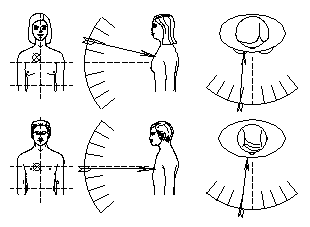
Average assemblage point location for male and female.
Patients with a bright and energetic disposition (a high vibrational rate) will have a high location and elevated entry angle. Depressed and lethargic patients, such as those suffering from M.E., post-natal or clinical depression, will have a low location and descending entry angle. Finding the location and entry angle for patients with mental or physical health problems can be difficult in the beginning, but gets easier as one gains experience. Often their symptoms, posture, and tone of voice will suggest where to look. The ‘off centre’ map provides a general overview of locations for specific physical and psychological symptoms. There are, however, exceptions to these.
Feeling The Location Of The Assemblage Point
The following is one example of the numerous methods used to locate the Assemblage Point:
1. The person should stand upright, looking ahead at the horizon. The investigator should stand facing the person’s right-hand body side.
2. Form your left hand into a shallow cup shape. Use it to ‘feel’ for the person’s Assemblage Point at the back around the area between the shoulder blades.3. Form the fingers and thumb of your right hand into a tight, concentrated point, like a ‘bird’s beak’. Use the finger tips of the right hand to ‘feel’ for the cluster of energy lines entering the person’s chest.
4. Hold both of your arms wide apart. Hold your left hand behind the person and your right hand in front. Standing relaxed, be keenly aware of your physical feelings and your weight on the floor. It helps to close your eyes or look away. Moving both hands in a slow circular motion, slowly bring your hands towards the back and towards the chest, feeling for the maximum energy disturbance or potential in the finger tips of your right hand and in the palm of your left hand. Allow the person’s energy lines to control your arm muscles.
5. The difference in energy potential along the collection of energy lines of the Assemblage Point is easy to distinguish, being concentrated and stronger closer to the chest. When your cupped left hand and right hand pointed fingers are lined up with the person’s cluster of energy lines, you will experience an ‘energy surge’. This will pass along your arms and through your chest between your shoulders.
6. Bring your hands together, feeling for the maximum power and connection with the person. Allow your hands to touch the person’s back and chest at the points of maximum energy connection.
7. Move your right-hand fingers back and forth across the energy lines of the Assemblage Point. Most subjects will feel a ‘pulling’ sensation deep inside their chest. Use small, adhesive labels to mark the front and rear position.
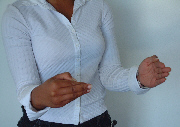
How to form your fingers and hands
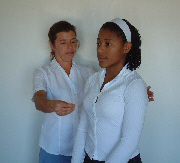
Feeling for the Location
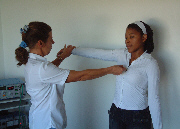
Muscle reflex locating
Confirming the Location
At the location of the Assemblage Point, the skin is less resilient and more painful to the touch. The skin may occasionally be blemished or marked in some way, sometimes by a small diameter reddish spot. Touching or pushing the spot with a finger tip will cause the skin to redden more than skin elsewhere on the chest. The spot is tender, sore or uncomfortable. Pushing it causes the person a feeling of slight unease. The feeling passes deep into the chest, often right through to the shoulder blade or the place of exit at the rear. Any sensitive person touching the precise location of a person’s Assemblage point will feel an exchange of energy. It will feel like a faint or weak electric shock and often has a vibrating quality to it.
How To Locate Your Own Assemblage Point
1.1) Provided that one is in good health and given a little time and some personal resolution, it is relatively easy to locate one’s own Assemblage Point.
1.2) Use a peaceful warm environment. Refer to the map for the average location for males and females above.
1.3) Using the tip of your index finger of your left hand. Press moderately firmly into the tissue of the right side your chest in the average location for male and females.
1.4) Remove your finger and press firmly again in a very-close adjacent spot. Repeat this until you have covered a diameter of perhaps 10 centimetres (4 inches).
1.5) When you find your location it will be very tender, even sore or painful. With most individual, the sensation will pass deep into the chest, perhaps through to the back.
When you have located your Assemblage Point
2.1) Using the above strategy, then you can apply pressure on the tender point and change the angle of you finger to estimate the front entry/rear exit angle of the energy line of your AP. Here, it is better to use the straightened index or second finger of your right hand. When you perceive your entry angle correct, then you may well feel the energy line passing through your chest to a point on your back. If so, then you will know your rear exit location.
2.2) If you have an anxious nervous disposition or experience (hypertension) then the location and entry angle will be higher than average (Fig. 6).
2.3) If you have a steadfast character then the location will be closer to the vertical centre chest line but slightly on the right side. The entry angle will not be deviated but straight (dead ahead) (Fig. 7).
2.4) If you are generally down in mood or experience depression (hypo-tension) then the location and entry angle will be lower (Fig.8).
Points to Bear in Mind
3.1) If you are on the large side, you must press harder to penetrate through the subcutaneous tissue to the rib cage.
3.2) If you are female and have a disposition as outlined in 2.2 or 2.3 above, then your Assemblage Point may well be in your breast. Your cup size and age will determine how hard you have to press. In any event you will not feel the tender point on the surface of your breast. You must press into your breast, into the rib cage.
Benefits of Knowing the Location and Entry Angle of Your Assemblage Point
4.1) When you know the location of your AP, you will be able to check it and compare it against your state of physical and emotional health. For example should you experience intimidation and get angry, then the location and entry angle will move towards the right. It may take you several days to recover your normal composure and the AP to return to its normal location for you. If you experience a trauma, lets say bereavement for example, then your Assemblage Point location and entry angle will be in a lower position than normal. Depending on your personality type and general health, will determine how quickly you and your AP recovers, to your normality.
4.2) When you know and are familiar with your own Assemblage Point, the easier it will become for you to locate and diagnose the AP of others. If you are not totally familiar with you own AP, you will not be able to locate and correct the alignment of other people.
For comprehensive information and instructions on locating and correcting the location and entry angle of the Assemblage Point, please refer to Ebooks and paperbacks entitled:

Figure 6.
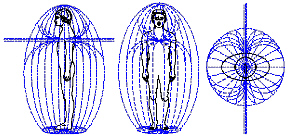
Figure 7.

Figure 8.

